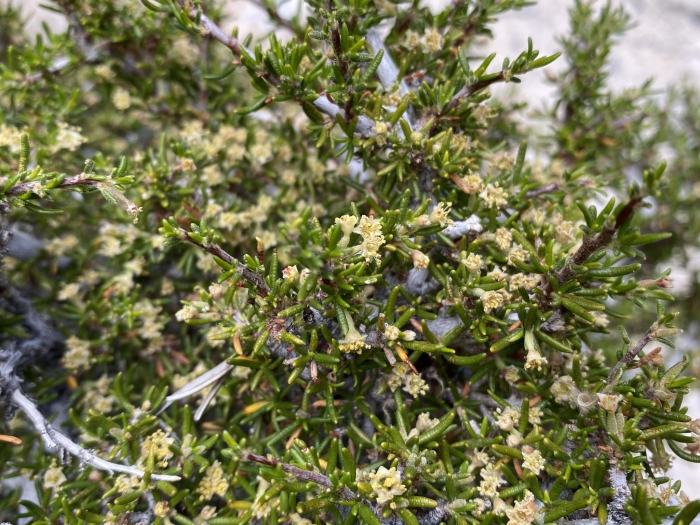Littleleaf Mountain Mahogany
(Cercocarpus intricatus)
Littleleaf Mountain Mahogany (Cercocarpus intricatus)
/
/

Matt Berger
CC BY 4.0
Image By:
Matt Berger
Recorded By:
Copyright:
CC BY 4.0
Copyright Notice:
Photo by: Matt Berger | License Type: CC BY 4.0 | License URL: http://creativecommons.org/licenses/by/4.0/ | Rights Holder: Matt Berger | Publisher: iNaturalist | Date Created: 2020-05-18T21:05:40Z |




















































Estimated Native Range
Summary
Cercocarpus intricatus, commonly known as Littleleaf Mountain Mahogany, is an evergreen shrub native to the chaparral, scrublands, and rocky slopes of the Western United States, particularly in the Great Basin and surrounding areas. This plant typically reaches a height and width of 3-5 feet (0.9-1.5 meters), with a dense, rounded form that provides habitat and cover for wildlife. Its small, leathery leaves are adapted to the dry conditions of its native habitat.
Littleleaf Mountain Mahogany is valued for its drought tolerance and ability to thrive in poor, rocky soils, making it an excellent choice for xeriscaping and naturalistic plantings in arid regions. It is also used for erosion control on slopes. The plant’s most distinctive feature is its spring-blooming white flowers, which, although small, are quite showy due to their numerous long, feathery styles that persist after the petals fall, giving the appearance of a silvery plume. These unique seed tails can add textural interest to the garden throughout the year. In cultivation, it requires full sun, minimal water once established, and well-drained soils. While generally low-maintenance, it can be affected by root rot if overwatered or planted in poorly drained soils.CC BY-SA 4.0
Littleleaf Mountain Mahogany is valued for its drought tolerance and ability to thrive in poor, rocky soils, making it an excellent choice for xeriscaping and naturalistic plantings in arid regions. It is also used for erosion control on slopes. The plant’s most distinctive feature is its spring-blooming white flowers, which, although small, are quite showy due to their numerous long, feathery styles that persist after the petals fall, giving the appearance of a silvery plume. These unique seed tails can add textural interest to the garden throughout the year. In cultivation, it requires full sun, minimal water once established, and well-drained soils. While generally low-maintenance, it can be affected by root rot if overwatered or planted in poorly drained soils.CC BY-SA 4.0
Plant Description
- Plant Type: Shrub
- Height: 3-5 feet
- Width: 3-5 feet
- Growth Rate: Moderate
- Flower Color: White
- Flowering Season: Spring
- Leaf Retention: Evergreen
Growth Requirements
- Sun: Full Sun
- Water: Low, Medium
- Drainage: Fast
Common Uses
Bee Garden, Deer Resistant, Fire Resistant, Fragrant, Low Maintenance, Rock Garden
Natural Habitat
Native to chaparral, scrublands, and rocky slopes in the Western United States
Other Names
Common Names: Littleleaf Mountain-Mahogany, Narrowleaf Mahogany, Dwarf Mountain Mahogany
Scientific Names: , Cercocarpus intricatus, Cercocarpus ledifolius var. intricatus, Cercocarpus intricatus var. villosus, Cercocarpus intricatus var. intricatus, Cercocarpus hypoleucus, Cercocarpus intricatus subsp. hypoleucus, Cercocarpus intricatus var. hypoleucus, Cercocarpus intricatus var. typicus,
GBIF Accepted Name: Cercocarpus intricatus S.Watson